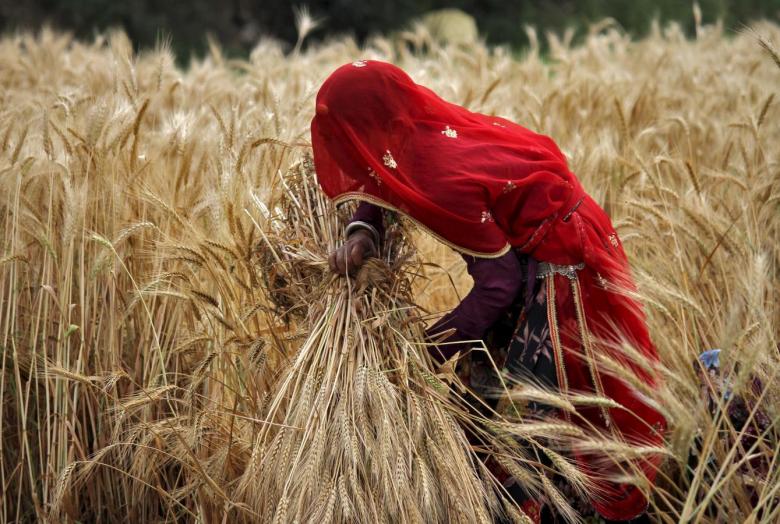Editor’s Note: This month, that is January 2021, FII’s #MoodOfTheMonth is Work and The Workplace, where we invite various articles to highlight the profound changes that our workplaces may or may not have undergone and the effect that these changes have had on our personal and professional lives and ways of living in the time of the pandemic. If you’d like to share your article, email us at pragya@feminisminindia.com.
As I contemplate and pen this article in a warm and sheltered room in one of the metropolitan cities of India, there is a throng of women-men alike protesting over the most contentious farm Bills. The recent happenings have forced all of us to go back and freshen our memory in hindsight of whether we are really an agrarian state. At least, the government policy says so and the kind of false romanticisation that is shown towards the peasants (by different political groups) also supports the claim of us being a socialist and an agrarian state.
The economic survey released by government of India in the year 2017-18, talks descriptively about how women are revolutionising the traditional male dominated farm sector, as more and more men in the family are readily migrating on large scale to these so called “big cities” in search of job security and to further improve their livelihoods. But when you go by the historical timelines, the argument of women resorting to agriculture forcefully (as is presented) seems unempirical. Or maybe by the patriarchal norm, the scene depicting a group of women laboriously working in a farm doesn’t seem very captivating to the male gaze. Thus, the habitual and perpetual ignorance towards women’s work continues as is the case in every other sector.
There are several historical accounts that bring forth the evidence of women being independently involved in agriculture when the population mostly consisted of hunters and gatherers. With increase in population, the cultural norms also changed. And as food scarcity became more rampant, gradually the burden of growing food fell upon the male shoulders due to the kind of physically straining work that agriculture used to be and women were limited to duties that were considered ‘feminine’ and ‘homely’.
The increased use of carcinogenic pesticides that has led to deterioration of health amongst the new age population and relinquishing use of natural and environment friendly farm practices is a testimony of how dearly the exit of women from the farms has cost the common people.
The consequence of which was that it bereft women with zero economic independence on their own and the social conditioning of man being a ‘provider’ raised its ugly head. The above practice in sometime became a norm worldwide and paved the way for most dreaded aspects of society; gender inequality. And from here; the inequality got fostered in other spheres as well.
Even traditionally, women have long been associated with the environment—our festivals like Lohri in Punjab and Raja Parba in the coastal state of Odisha are a proof of the same. The increased use of carcinogenic pesticides that has led to deterioration of health amongst the new age population and relinquishing use of natural and environment friendly farm practices is a testimony of how dearly the exit of women from the farms has cost the common people.
As per the stats that is available on different government websites, the women percentage in the agriculture sector is close to 85%. Women make up for about 33% cultivators and about 48% as agricultural labourers. And if we try to dig deeper, the kinds of crop plantations like tea, cotton, oil, etc. that these women engage in, is labour intensive and highly skilled. Yes, they do seem like a dominating force in fields but reality is far from the truth and these women have always been deemed to a disadvantageous position in terms of land rights, wages, representation in decision making, familial health. If we are still talking about their ‘empowerment’ in 21st century, their scuffle for affordable quality education can be well thought of.
Also read: The Impact Of Customary Laws On Women Farmers In India
These women continue to wait for development to reach their doorsteps and affect their lives in a significant way. Government institutions engaged in policy making need to bring some long anticipated institutional and structural reforms in this direction. Merely by naming a day for these women farmers (not labourers) is not going to ease their plight in any manner. (The Ministry of Agriculture and Farmers Welfare has declared 15th October of every year as Women Farmer’s Day.)
Government institutions engaged in policy making need to bring some long anticipated institutional and structural reforms in this direction. Merely by naming a day for these women farmers (not labourers) is not going to ease their plight in any manner.
Therefore, government schemes should focus more on reforms like enhanced access to land, water and credit facilities for these women coupled with other institutional facilitations. These reforms become critical and should involve adequate women representation. As I am writing this article, I am struck by the sudden thought of Jane Austen’s celebrated character Anne Elliot from her last completed novel, Persuasion. Where Anne tries to prove her friend Captain Benwick that, “Men have had every advantage of us in telling their own story.”
I suppose, so becomes the case when a group of socially, economically empowered people try to legislate the one less empowered and in this case, they are male parliamentarians. Be it in the case of property, and rights as fundamental as the right to marry , the case of bodily autonomy, of succession, universal suffrage and several others; men had the prerogative to subjugate women through legislation. And in some nations, they still continue to do so.
Globally, institutions have started to believe that women farmer’s participation is vital not just for yield but is also significant in preserving local agro-biodiversity. The Mizo tribe of Mizoram is one of the only seven sister states which observes large numbers of participation from its women farmers in the rugged terrain of this hill state.
The fact that abuse against women is somehow linked to land ownership rights seems very shocking and alarming to read. Women, both in rural and urban India rarely enjoy land ownership and the case of physical and verbal abuse have been recorded highest amongst those who didn’t hold ownership on any land (ancestral or marital) in their name. The Nobel prize winning author and economist, Amartya Sen is a vehement supporter of granting land access to women and argues that economic empowerment is a critical step to realise the goal of gender equality.
The night that feels the coldest, always ends with warm days. The situation does looks grim and murky but we all can change the stagnant status quo by demanding better, by asking for what rightfully belongs to the most deserving, by learning to delineate our preferences, by challenging wrong societal norms, by spreading awareness, by not conforming to ideals and ideas of others or the least affected, by giving enough breathable space to heterogeneous views and lastly, by continuous education of our women of all age groups, of all religion, of every ethnicity, of all colours.
Also read: How To Mitigate The Impact of Climate Change On Agriculture
References
Featured Image Source: The Wire
About the author(s)
Headstrong and Non-conformist.Likes Complex Female Characters.
Currently, striving to thrive.
You can reach her at – anubham95@gmail.com





